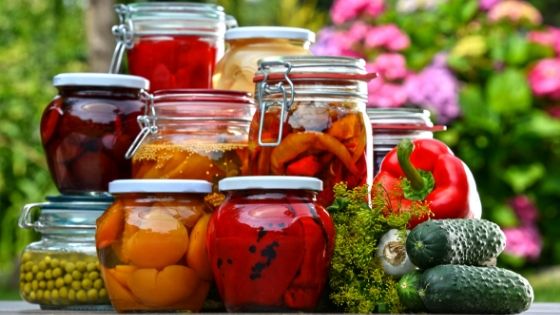A home vegetable garden can provide you and your family with an abundance of healthy and delicious food. Today we’re providing some methods for preserving fresh garden vegetables. The extra garden goodies can be preserved so that your family can enjoy them all year long. Traditionally, foods were dried or cured. Don’t worry though, these aren’t your only options to preserve your food. Modern methods allow us to preserve foods in ways that are safe and delicious.

Drying
Drying is a great way to preserve fruits. Line the fruit or slices of the fruit on trays in a food dehydrator and remove all of the moisture from them. The fruit becomes a sweet treat that everyone will love, especially kids. Try this with berries, apples, mangoes or your favorite fruit.
Jellies or Jams
Jellies or jams are made by combining fruit and sugar with pectin (a preservative naturally found in many fruits). Once the jelly or jams are prepared, they can be sealed in jars for you to enjoy or share with friends. Berries, pears, peaches, apples, plums and most fruits can be turned into a delicious jam or jelly. You can even forage for wild growing fruits, like muscadines, black berries or crab apples and turn these into amazing jellies or jams.
Root Cellars
A root cellar is an underground room where root vegetables can be stored. Root cellars are cool, dark, dry rooms, so if you don’t have a root cellar, you can create a similar space in your home. Food like potatoes, carrots and onions keep well in a root cellar. You can also store some other foods in a root cellar, like pumpkins or apples. Pumpkins should be shelved and stored without touching each other. Apples should be wrapped and stored without touching each other as well.
Freezing
Freezing foods is a simple way to store extra garden foods. Most fruits and vegetables should be blanched before being frozen to stop the ripening process. Once the foods are blanched, put them into freezer bags, remove as much of the air as you can, and put them into the freezer. Foods like meat and milk can also be easily frozen. Packages that are about to go out of date can be popped into the freezer to extend the shelf life.
Pickling
When I mention pickling as a method of food preservation, you probably immediately thought of dill pickles. You can preserve so much more than dill pickles. The process of pickling involves combining sugar and vinegar, boiling the mixture and then adding the food you intend to pickle. There are so many ways to pickle cucumbers (pickles), green tomatoes, eggs, jalapenos, banana peppers, and even watermelon rind.
Vacuum Sealing
A vacuum sealer can be an amazing investment if you really want to extend the shelf life of your foods. Vacuum sealers remove all of the air from a package and then seal it tightly. Dehydrated foods that are vacuum sealed can be stored on the shelf, while everything else will need to be frozen.
Canning
Canning is an old method of preserving that can be used to recreate almost any food item that you can purchase in the grocery store that comes in a can. Fruits, vegetables, meats, broths and everything in between can be stored in jars. Jars can be sealed using a water bath or a pressure canner.
If you’re looking to can your Hoover’s Hatchery broiler chickens check this post out: How To Safely Can Poultry Meat.